Indian Society & Social Justice - 5 | Current Affairs & Hindu Analysis: Daily, Weekly & Monthly - UPSC PDF Download
| Table of contents |

|
| Tribal Welfare |

|
| Social Isolation and Loneliness |

|
| Draft National Menstrual Hygiene Policy, 2023 |

|
| Surrogacy in India |

|
| India Ageing Report 2023 By UNFPA-INDIA |

|
Tribal Welfare

Context
- On November 15th, observed as Janjatiya Gaurav Diwas, the Prime Minister introduced three significant initiatives to enhance the welfare and protect the rights of Particularly Vulnerable Tribal Groups (PVTGs). These include the 'Viksit Bharat Sankalp Yatra,' which focuses on the developmental journey of tribal communities. Additionally, the Pradhan Mantri Particularly Vulnerable Tribal Groups (PM PVTG) Development Mission aims to address the specific developmental needs of PVTGs.
- Furthermore, the Pradhan Mantri Janjati Adivasi Nyaya Maha Abhiyan was launched to ensure justice and safeguard the rights of tribal communities, emphasizing targeted interventions for their upliftment. Together, these initiatives signify a dedicated effort to bring positive changes to the lives of Particularly Vulnerable Tribal Groups, emphasizing development and justice tailored to their unique needs.
What are these Key Initiatives?
- PM Janjati Adivasi Nyaya Maha Abhiyan (PM JANMAN):
- About: PM JANMAN aims to protect and nurture tribal groups, especially those on the verge of extinction, by providing them with necessary support, development, and connectivity to mainstream services and opportunities.
- Coverage: The initiative covers 75 Particularly Vulnerable Tribal Groups (PVTGs) residing in 18 states and union territories, spread across 22,544 villages in 220 districts.
- Approximately 28 lakh people belong to these identified tribal groups.
- Significance: PM JANMAN underscores the government's commitment to uplifting and safeguarding tribal communities, preserving their cultural heritage, and integrating them into the mainstream development process.
- It emphasizes the need to bridge the gap between tribal populations and essential services while ensuring their socio-economic empowerment.
- Viksit Bharat Sankalp Yatra:
- The focus of the Yatra will be on reaching out to people, creating awareness and providing benefits of welfare schemes like sanitation facilities, essential financial services, electricity connections, access to LPG cylinders, housing for the poor, food security, proper nutrition, reliable healthcare, clean drinking water, etc.
- Enrolment of potential beneficiaries will be done through details ascertained during the Yatra.
- The Yatra will start from districts with significant tribal populations initially and will cover all districts across the country.
- PM PVTG Mission:
- The PM-PVTG Development Mission program aims to improve the socio-economic status of Vulnerable Tribal Groups (PVTGs).
- For this, availability of Rs 24000 Crore for Scheduled Tribes has been envisaged in the Union Budget.
- The mission includes providing basic facilities like safe housing, clean drinking water and sanitation, education, health and nutrition, better access to roads in settlements for backward scheduled tribes.
- The PM-PVTG Development Mission program aims to improve the socio-economic status of Vulnerable Tribal Groups (PVTGs).
What are the Other Government Initiatives Related to Tribals?
- TRIFED
- Digital Transformation of Tribal Schools
- Development of Particularly Vulnerable Tribal Groups
- Pradhan Mantri Van Dhan Yojana
- Mahatma Gandhi National Rural Employment Guarantee Act (MGNREGA)
Social Isolation and Loneliness

Context
Social exclusion is a intricate and multi-dimensional occurrence that involves restricting or denying individuals' involvement in the economic, social, and cultural aspects of their community. This dynamic process is influenced by various factors such as poverty, discrimination, and the absence of opportunities in education and employment. The consequences of social exclusion are substantial, affecting individuals and communities profoundly by inducing social isolation, marginalization, and deprivation.
What is Social Exclusion in Sociology
In sociology, social exclusion is defined as the process by which individuals or groups are denied full participation in society. This can be due to a variety of factors, including poverty, discrimination, and lack of access to resources and opportunities. Social exclusion can have a number of negative consequences for individuals and communities, including social isolation, marginalization, and deprivation.
Types of Social Exclusion
There are many different types of social exclusion, and the specific experiences of excluded individuals and groups can vary widely.
However, some common types of social exclusion include:
- Economic exclusion: This refers to the denial of access to economic resources and opportunities, such as employment, education, and healthcare.
- Social exclusion: This refers to the denial of access to social networks and relationships, such as family, friends, and community groups.
- Cultural exclusion: This refers to the denial of access to cultural activities and resources, such as language, religion, and the arts.
Dimensions of Social Exclusion
- Economic Exclusion:
- Denial of access to economic resources and opportunities.
- Includes limited employment opportunities, insufficient wages, and lack of access to financial services.
- Can lead to poverty, homelessness, and hunger.
- Social Exclusion:
- Denial of access to social networks and relationships.
- Involves discrimination based on race, gender, or ethnicity, leading to social isolation.
- Limited access to education and healthcare.
- Results in loneliness, isolation, and marginalization.
- Cultural Exclusion:
- Denial of access to cultural and recreational activities.
- Limited representation in media and cultural narratives.
- Disregard for diverse cultural practices.
- Can cause a disconnection from cultural heritage and identity.
Intersecting Dimensions
- Dimensions often intersect, creating a complex web of disadvantage.
- For instance, economic exclusion may coexist with social or cultural exclusion due to discrimination, stigma, or lack of representation.
Examples of Social Exclusion
- Homeless individuals excluded from social activities.
- People with disabilities excluded from employment opportunities.
- Minority ethnic groups facing exclusion from social networks.
- Low-income youth excluded from educational opportunities.
Impact of Social Exclusion
- Leads to social isolation, marginalization, and deprivation.
- Increases the likelihood of poverty, unemployment, crime, and poor health.
Addressing Social Exclusion
- Raise awareness and challenge associated stigma.
- Develop policies and programs promoting social inclusion and reducing inequality.
- Focus on prevention through early childhood education.
- Address root causes such as poverty, discrimination, and inequality.
Unique Insights
- Social exclusion is a complex issue but not inevitable.
- Prevention through early childhood education is crucial.
- Address root causes like poverty and discrimination for full societal participation.
Conclusion
Social exclusion has profound impacts, requiring awareness, policies, and programs to promote inclusion and reduce inequality.
Draft National Menstrual Hygiene Policy, 2023

Context
The Draft Menstrual Hygiene Policy of the Central Government has been made available for public and expert comments through an online platform.
Objectives of the Policy
- Ensure the provision of safe, hygienic, and high-quality menstrual products and sanitation facilities for menstruating women and girls.
- Establish an inclusive environment for individuals, including women, girls, men, and boys, to access accurate information about menstruation.
- Tackle myths, eliminate stigma, and address gender-related issues associated with menstruation.
- Collaborate with various Central Government Ministries, States/UTs, and relevant stakeholders across sectors.
- Promote a menstruation-friendly atmosphere in diverse settings, including households, schools, workplaces, and public spaces.
- Encourage innovative approaches in collaboration with social entrepreneurs and the private sector.
- Enhance environmentally sustainable practices for menstrual waste disposal.
Key Principles of the Policy
- Access and Affordability: Improving access to safe menstrual hygiene products and to reduce the financial burden of menstruation on individuals and families, particularly for those in low-income communities and marginalized groups.
- Equity: Prioritize equity to enable all menstruating individuals, regardless of their socioeconomic status and geographical location, to have equal opportunities to access and manage their menstruation in a safe and hygienic way.
- Address disparities and barriers that prevent certain groups from accessing required menstrual hygiene products, resources and information.
- Inclusivity: All women and adolescent girls, persons with disabilities, ethnic groups, minorities, trans and nonbinary populations, vulnerable populations and specially identified groups will be specifically focused on.
- The policy also targets men and boys at the family and community level through awareness programs to strengthen men’s roles and build a conducive environment.
Surrogacy in India

Context
- The Ministry of Health and Family Welfare introduced the Surrogacy (Regulation) Bill, 2019 in Lok Sabha on July 15, 2019.
- The Union Cabinet granted approval to the Surrogacy (Regulation) Bill, 2020, incorporating all recommendations from the Rajya Sabha Select Committee before its approval.
- The Bill successfully passed in the Rajya Sabha and obtained Presidential consent on December 29, 2021, officially becoming an act.
What is surrogacy?
- The act defines surrogacy as a practise where a woman gives birth to a child for an intending couple to hand over the child after the birth to the intending couple.
- The Act will constitute the National Assisted Reproductive Technology and Surrogacy Board, State Assisted Reproductive Technology and Surrogacy Boards, and the appointment of appropriate authorities for regulation of the practice and process of surrogacy.
Surrogacy Regulation in India
The Act prohibits commercial surrogacy but allows altruistic surrogacy.
- Altruistic surrogacy involves no monetary compensation to the surrogate mother other than the medical expenses and insurance coverage during the pregnancy.
- Commercial surrogacy includes surrogacy or its related procedures undertaken for a monetary benefit or reward (in cash or kind) exceeding the basic medical expenses and insurance coverage.
Conditions for permitting surrogacy
- For intending couples who suffer from proven infertility.
- Altruistic
- Not for commercial purposes
- Not for producing children for sale, prostitution, or other forms of exploitation
- For any condition or disease specified through regulations.
Eligibility criteria for intending couple
- For couples intending to undergo surrogacy, it is required to obtain a 'certificate of essentiality' and a 'certificate of eligibility' from the appropriate authority.
The 'certificate of essentiality' is issued upon meeting the following conditions:
- Proven infertility of one or both members of the intending couple as certified by a District Medical Board.
- An order of parentage and custody for the surrogate child from a Magistrate’s court.
- Insurance coverage for 16 months, including postpartum delivery complications for the surrogate.
The 'certificate of eligibility' is issued based on the following conditions:
- The intending couple must be Indian citizens married for at least five years.
- The wife's age should be between 23 to 50 years, and the husband's age should be between 26 to 55 years.
- The couple should not have any surviving child, including biological, adopted, or surrogate, except for children with specific conditions.
Eligibility criteria for surrogate mothers include being a close relative of the intending couple, being a married woman with a child of her own, aged between 25 to 35 years, surrogacy allowed only once in her lifetime, possessing a certificate of medical and psychological fitness, and not providing her gametes for surrogacy.
Other provisions of the Surrogacy Regulation Act include the establishment of National and State Surrogacy Boards, determining the parentage of the child born through surrogacy, regulations on abortion, and offenses with penalties such as imprisonment up to 10 years and a fine of up to 10 lakh rupees for activities like commercial surrogacy, exploiting surrogate mothers, abandoning or disowning a surrogate child, and selling or importing human embryos or gametes for surrogacy.
Criticisms of Indian surrogacy regulations
- Altruistic Surrogacy Model Critique:
- Altruistic surrogacy model expects women to undergo surrogacy without compensation.
- This expectation is paternalistic, impractical, and rooted in a patriarchal approach.
- Denies surrogates a legitimate income source, limiting willing participants and depriving intending parents of the option.
- Exclusions in the Proposed Bill:
- The proposed Bill excludes LGBTQ+ individuals, live-in couples, and single parents.
- Requirement for a 'certificate of essentiality' proving biological impossibility for alternative childbirth methods.
- Overlooks medical conditions that may not render women infertile but make pregnancies riskier.
- Fails to consider cases where women may choose not to undergo pregnancy due to career commitments.
- Limitations and Needed Reforms:
- More reforms are required to recognize surrogacy as a reproductive right.
- The current regulation falls short in protecting the bodily autonomy of surrogates and the right to parenthood for intending parents.
- Availing surrogacy should be acknowledged as a legitimate reproductive choice.
- Penalties and Offenses:
- The Bill penalizes commercial surrogacy, exploitation of surrogate mothers, abandoning or exploiting surrogate children, and selling or importing human embryos or gametes for surrogacy.
- Penalties include imprisonment up to 10 years and fines up to 10 lakh rupees for such offenses.
- Call for a Comprehensive Approach:
- The proposed Bill's approach is paternalistic and unrealistic.
- Comprehensive reforms should consider the broader spectrum of cases, including reproductive rights, medical conditions, and personal choices regarding pregnancy.
- The goal should be to protect the rights and choices of both surrogates and intending parents.
India Ageing Report 2023 By UNFPA-INDIA

Context
This article draws insights from the "Caring for Our Elders – Institutional Responses – UNFPA India" report, which was published in collaboration between UNFPA (United Nations Population Fund) India and the International Institute for Population Sciences (IIPS). The information is based on the findings and content presented in the India Ageing Report 2023 released by UNFPA India.
What are key highlights of the India Ageing Report 2023?
- It highlights the challenges, opportunities, and institutional responses related to elderly care in India, as India navigates a demographic shift towards an aging population.
- Population ageing is associated with a rise in the proportion of the population termed as ‘old’, usually at 60 or 65 years and above.
- It represents a thorough review of the living conditions and welfare of older individuals in India.
- It leverages the latest data available from the Longitudinal Ageing Survey in India (LASI), 2017–18, Census of India, Population Projections by the Government of India (2011–2036), and World Population Prospects 2022 by the United Nations Department of Economic and Social Affairs.
India Ageing Report 2023: Levels and Trends
- Prospects of the Older Population:
- The India Ageing Report indicates that the proportion of individuals aged 60 and above is anticipated to rise from 10.5 percent in 2022 to 20.8 percent in 2050.
- By the end of the century, seniors (60 years and older) are projected to constitute more than 36 percent of the total population in India.
- A notable shift is expected before 2050, with the elderly population surpassing the population of children aged 0–14 years.
- During this period, the demographic share of the age group 15–59 years is also expected to experience a decline, transforming India from a predominantly young society to a rapidly ageing one.
- State Differentials:
- As per the India Ageing Report, several southern states and specific northern states like Himachal Pradesh and Punjab reported a higher proportion of elderly individuals compared to the national average in 2021.
- The gap in the percentage of elderly population between these states and the national average is projected to widen by 2036.
- Decadal Growth of the Elderly Population:
- The growth rate of the elderly population in India exhibited a slight decline from 32 percent between 1961 and 1971 to 31 percent in 1981–1991.
- However, growth gained momentum during 1991–2001, reaching 35 percent, and is anticipated to increase significantly to 41 percent between 2021 and 2031.
What are the challenges of an ageing population?
- Feminization of the Aging Population:
- The aging crisis is centered around women, who typically outlive men, leading to a feminization of the elderly population.
- Women, often out of the labor force, face financial vulnerability due to a lack of savings, making them more susceptible to health issues.
- Women are generally less informed about government schemes compared to men.
- The proportion of the elderly population is projected to double, reaching 20.8% by 2050.
- Ruralization:
- According to the 2011 Census of India, approximately 71% of older individuals reside in rural areas.
- Rural regions face challenges such as poor transportation, income insecurity, limited access to quality healthcare, and social isolation, intensifying issues for elderly residents.
- Ageing of the Aged:
- From 2000 to 2022, the country's total population grew by 34%, whereas the population of those aged 60 and above surged by 103%.
- The population growth is even more pronounced for individuals aged 80 and above, reaching 128% during the same period.
- Poor Health:
- Aging is linked to poor health due to chronic morbid conditions and declining physiological capacity.
- Disability becomes a significant concern with age, increasing the caregiving burden.
- Over 30% of elderly women and 28% of men suffer from at least one chronic morbid condition, while a quarter endure more than two.
- Physical Impairment and Disabilities:
- Women aged over 80 report a higher incidence of impairments (179 per 1,000) compared to men (119 per 1,000).
- Among those aged 60 and above, the incidence of any impairment is found to be 105 per 1,000 population.
- Mental Health:
- According to the LASI survey, depression incidence rises with age, particularly among elderly women compared to men.
- Pension-Related Issues and Income Security:
- There is a lack of dedicated funding for the care of older individuals, raising concerns about income security and pension-related matters.
What are the existing laws for older persons in India?
- Maintenance and Welfare of Senior Citizens Act, 2007: The act lays down measures for providing maintenance and support to elderly parents and senior citizens.
- National Policy on Older Persons(NPOP) 1999: It acknowledges population ageing and lays down a strategy to address the demographic change.
- National Council of Senior Citizens: It suggested forming an advisory body for framing policies and programmes for senior citizens.
- Senior Citizens’ Welfare Fund: It provides financial assistance to schemes that promote financial security, healthcare, and nutrition of senior citizens.
What are the government schemes for elderly people?
- Atal Vayo Abhyuday Yojana: It provides financial assistance for the running and maintenance of Senior Citizen Homes/ Continuous Care Homes.
- Rashtriya Vayoshri Yojana: It provides physical aids and assisted living devices to below-poverty-line (BPL) senior citizens suffering from age-related disabilities and infirmities.
- Vayoshreshtha Sammans: This scheme is applicable to eminent senior citizens and institutes involved in rendering distinguished services for the cause of elderly persons.
- Indira Gandhi National Old Age Pension Scheme (IGNOAPS): It provides social assistance for old age persons.
- National Social Assistance Programme: It provides support to aged persons, widows, disabled persons, and bereaved families on the death of a primary breadwinner, belonging to BPL households.
Way Forward
- Mobile Clinics for the Elderly: Introduction of mobile clinics for the elderly, inspired by projects like Kerala's Vayomithram, offering free healthcare, medicines, and palliative care.
- Regulatory Body for Old Age Homes: Establishment of a regulatory body to monitor and govern private old age homes, ensuring they comply with standards and regulations.
- Elderly Self-Help Groups (ESHG):
- Active promotion and support for Elderly Self-Help Groups, connecting them with livelihood programs and providing resources for product creation and market sale.
- Implementation of the Action Groups Aimed at Social Reconstruction (AGRASR) Program to enhance the functionality and self-sufficiency of Senior Citizens SHGs at the village level.
- Creche for the Elderly: Development of creche-like facilities or day-care centers for the elderly, allowing them to stay during the day when family members are unavailable.
- Mental Health Programs: Inclusion of companionship programs for senior citizens during the daytime through day-care centers, following models like the Pakal Veedu project in Thrissur.
- Digital Literacy: Implementation of regular training programs for the elderly, focusing on digital literacy, including computers, the internet, and new communication methods.
- Awareness Programs:
- Ensuring rural areas are informed about and benefit from elderly-focused schemes, with special attention to addressing the needs of elderly women.
- Addressing low awareness levels, as indicated by the LASI Report, where only 12 percent of the elderly were aware of schemes like Annapurna.
|
38 videos|5269 docs|1114 tests
|














